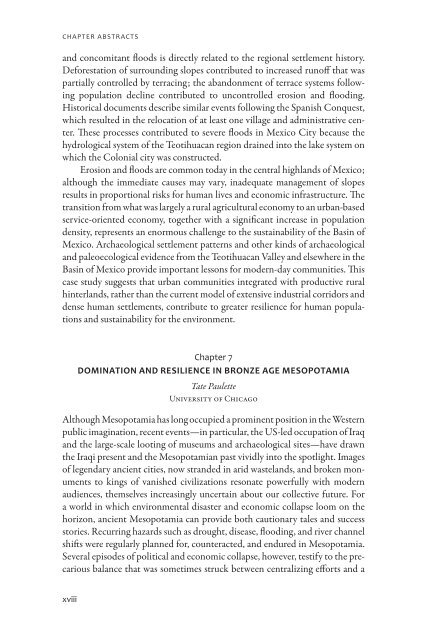free download - University Press of Colorado
free download - University Press of Colorado
free download - University Press of Colorado
You also want an ePaper? Increase the reach of your titles
YUMPU automatically turns print PDFs into web optimized ePapers that Google loves.
Chapter Abstracts<br />
and concomitant floods is directly related to the regional settlement history.<br />
Deforestation <strong>of</strong> surrounding slopes contributed to increased run<strong>of</strong>f that was<br />
partially controlled by terracing; the abandonment <strong>of</strong> terrace systems following<br />
population decline contributed to uncontrolled erosion and flooding.<br />
Historical documents describe similar events following the Spanish Conquest,<br />
which resulted in the relocation <strong>of</strong> at least one village and administrative center.<br />
These processes contributed to severe floods in Mexico City because the<br />
hydrological system <strong>of</strong> the Teotihuacan region drained into the lake system on<br />
which the Colonial city was constructed.<br />
Erosion and floods are common today in the central highlands <strong>of</strong> Mexico;<br />
although the immediate causes may vary, inadequate management <strong>of</strong> slopes<br />
results in proportional risks for human lives and economic infrastructure. The<br />
transition from what was largely a rural agricultural economy to an urban-based<br />
service-oriented economy, together with a significant increase in population<br />
density, represents an enormous challenge to the sustainability <strong>of</strong> the Basin <strong>of</strong><br />
Mexico. Archaeological settlement patterns and other kinds <strong>of</strong> archaeological<br />
and paleoecological evidence from the Teotihuacan Valley and elsewhere in the<br />
Basin <strong>of</strong> Mexico provide important lessons for modern-day communities. This<br />
case study suggests that urban communities integrated with productive rural<br />
hinterlands, rather than the current model <strong>of</strong> extensive industrial corridors and<br />
dense human settlements, contribute to greater resilience for human populations<br />
and sustainability for the environment.<br />
Chapter 7<br />
Domination and Resilience in Bronze Age Mesopotamia<br />
Tate Paulette<br />
<strong>University</strong> <strong>of</strong> Chicago<br />
Although Mesopotamia has long occupied a prominent position in the Western<br />
public imagination, recent events—in particular, the US-led occupation <strong>of</strong> Iraq<br />
and the large-scale looting <strong>of</strong> museums and archaeological sites—have drawn<br />
the Iraqi present and the Mesopotamian past vividly into the spotlight. Images<br />
<strong>of</strong> legendary ancient cities, now stranded in arid wastelands, and broken monuments<br />
to kings <strong>of</strong> vanished civilizations resonate powerfully with modern<br />
audiences, themselves increasingly uncertain about our collective future. For<br />
a world in which environmental disaster and economic collapse loom on the<br />
horizon, ancient Mesopotamia can provide both cautionary tales and success<br />
stories. Recurring hazards such as drought, disease, flooding, and river channel<br />
shifts were regularly planned for, counteracted, and endured in Mesopotamia.<br />
Several episodes <strong>of</strong> political and economic collapse, however, testify to the precarious<br />
balance that was sometimes struck between centralizing efforts and a<br />
xviii





